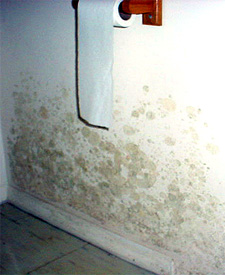 Mold
has been receiving a lot of attention due to the vast
amount of sickness and lawsuits that have been created.
Mold
has been receiving a lot of attention due to the vast
amount of sickness and lawsuits that have been created.
But, mold has just not started to cause problems today.
Mold has been documented as causes of the Ergot Epidemic that
affected Europe for 500 years due to mold-induced food poisoning,
and the Irish Potato Famine where mold killed the plants that
provided food.
Mold has been documented even back as far as the bible.
Since the 1970's, when there was a shortage of oil, home
construction has changed dramatically.
It is now common practice to heavily insulate homes, wrap the
exterior with a vapor barrier, and create less ventilation from
the outside air.
This can cause the potential for mold growth if there is a water
event. According to statistics from the Bureau of the Census,
35% of homes are damaged due to water or moisture yearly.
With the wood, cellulose, and other organic materials used in
building, this now provides a fertile platform for mold.
“A HEALTHY HOME”?
Homes that have been exposed to mold may have an adverse
effect on it’s property value. Well-informed Buyers
and Realtors may be more beneficial when making an intelligent
buying decision.
What kind of mold is in my house? Is it toxic mold?
Mold cannot be identified by sight and there are
thousands of species of mold. My job is the first step,
which is to collect samples and have the lab analyze them.
How did the mold get in my house?
Mold is everywhere and is not uncommon to find in
a home. It enters the house through openings or heating,
and mold spores attach to people and animals, bringing mold
indoors.
Where does mold grow?
Mold will grow in places where leakage may have occurred.
Many building materials can encourage mold growth once they
have become wet.
How can I tell if there is mold in my home?
Some mold problems are obvious, you will see it.
Other mold problems may be identified by Can I stop mold
from growing in my home?
Look for visible signs of water damage or heavy moisture
problems. Have these sources of water Intrusion corrected
and this will lessen the chances for mold growth. Mold activity
can occur as soon as 24 hours after a water loss.
How do you test for mold?
There are 2 typical methods of testing for mold.
One is air sampling where air samples are taken inside the home
and outside for comparison to detect a problem.
The other is a swab sample of the visible mold or stain to determine
the type of mold.
FREQUENTLY ASKED QUESTIONS:
What Is Mold?
Mold is simply a fungus. Like another
fungus, the mushroom, there are good molds and bad molds.
Some molds are used in making antibiotics, beer, and cheese,
while other types can be toxic and cause negative health effects.
But, the main purpose of mold is to break down dead materials,
like wood and fiber that are used in building materials.
Mold growth can start as soon
as 24 hours after a water event has occurred. Mold can often
be seen in the form of a discoloration or a stain.
When molds are present in large quantities, called colonies,
they become a health concern.
Molds are divided into 3 basic groups based on health effects:
Allergenic, Pathogenic, and Toxic Allergenic molds can cause
allergic symptoms such as wheezing or a runny nose.
Pathogenic molds can cause suppressed immune systems, or serious
health effects in a person who already has a decreased immune
system.
Toxic molds can cause serious health effects in almost everyone.
These effects may be short-term irritations to even cancer.
What Do I Do Now?
Mold Free Home VA realizes
the vast problems that are faced by the realtors, home
owners, and home buyers, and have set standards and protocols
for mold inspections.
There are 5
Levels of Inspection Services that are offered by the CERTIFIED
MOLD INSPECTOR.
Contact
Us to find out more about these services and
other services that are available.
Mold Free Home Va Services the
District of Columbia, the Washington, DC Metro Area of
Maryland and Virginia Regions.
Moldfreehomeva LLC is a Licensed and Insured Company.

